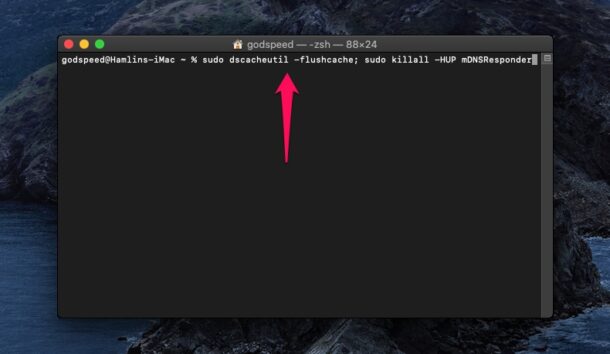I love playing with various OS's and in OSX is on top of my list. During the day I am managing IT from my old trusted Lenovo ThinkPad with Windows. At night I am using my MacBook PRO. And I love it. The more and more I use it for various tasks the more I am looking for alternatives to Windows commands.
Why would you flush DNS cache in the first place?
The process to reset and flush or clear DNS cache in macOS Big Sur is actually very easy. All it requires is for you to enter one command in the Terminal, and you're done. Well, technically, it's two commands in one line. If you want to flush DNS cache on a Mac, simply follow the steps below. There are several steps involved in flush DNS Cache in macOS Catalina which are very easy to follow. All you need to open Terminal on your mac to run a few commands. Further into the universe mac os. MacOS Catalina Open Terminal (Application – Utilities – Terminal or click Go- Utilities- Terminal).
Whenever there is a change in DNS, for example you change IP ADDRESS of a website, DNS is still caching old entry. But when you flush it, all the records are gone, then DNS will have to query DNS again to obtain the latest address.
I was asked by my friend how to flush DNS in Mac OS X… I didn't know, I admit. In the end it's fairly easy.
Flush DNS in Mac OS X Snow Leopard 10.6
Open terminal and type:dscacheutil -flushcache
Flush It Mac Os Pro
this is quite similar to windows, instead of ipconfig /flushdns you type dscacheutil -flushdns
Flush DNS in OS X Lion (10.7) and OS X Mountain Lion (10.8)
With Lion, there is a bit more typing to do. Luckily same applies to Mountaion Lion as well.
sudo killall -HUP mDNSResponder
dscacheutil still works in 10.8 and 10.7 but official method is to kill mDNSResponder. As alternative you can kill process in Activity monitor.
Flush DNS in OS X 10.9 Mavericks

If you are running 10.9 version of OS X, you will have to type even more, by executing command below you will do two things: 1. You will flush cache 2. then you will reload DNS for changes to come in effect.
dscacheutil -flushcache;sudo killall -HUP mDNSResponder

If you are running 10.9 version of OS X, you will have to type even more, by executing command below you will do two things: 1. You will flush cache 2. then you will reload DNS for changes to come in effect.
dscacheutil -flushcache;sudo killall -HUP mDNSResponder
How to clear DNS cache in OS X 10.10 Yosemite
To completely clear DNS cache in OS X 10.10, you will have to target MDNS – Multicast DNS and UDNS -Unicast DNS with two different commands but they can be merged in to one. Open terminal and type:
sudo discoveryutil mdnsflushcache;sudo discoveryutil udnsflushcaches;say flushed
You can also type each command separately.
In order to clear MDNS cache type in the following command:
sudo discoveryutil mdnsflushcache
Flush It Mac Os Catalina
In order to clear UDNS cache type in the terminal the following command:
sudo discoveryutil udnsflushcaches
Yes, it's not a mistake, you have to use plural
How to clear IOS DNS cache Click the button mac os.
IOS does not have a terminal which you can use to type in commands like in OS X. One solution which will work on IOS is to restart the device. But in this case, it will take a lot of time.
What you can do is to enable and disable flight mode. Go to Settings, Airplane mode and turn it ON. Wait for several seconds and turn Flight mode OFF. This will clear DNS cache. In IOS version 7 and above, you can pull up new menu at the bottom (quick access) and press first icon on the left – flight mode. Wait for several seconds, and press it again to turn flight mode off. You can use this method to clear DNS cache on iPhone and iPad.
Related
Flush It Mac Os Download
Download the Adobe Flash Player uninstaller:
- Mac OS X, version 10.6 and later: uninstall_flash_player_osx.dmg
- Mac OS X, version 10.4 and 10.5: uninstall_flash_player_osx.dmg
The uninstaller is downloaded to the Downloads folder of your browser by default.
In Safari, choose Window > Downloads.
If you are using Mac OS X 10.7 (Lion), click the Downloads icon displayed on the browser.
To open the uninstaller, double-click it in the Downloads window.
Note: If the Flash Player installer window does not appear, choose Go > Desktop in the Finder. Scroll down to the Devices section and click Uninstall Flash Player.
To run the uninstaller, double-click the Uninstaller icon in the window. If you see a message asking if you want to open the uninstaller file, click Open.
- Bookmark or print this page so that you can use the rest of these instructions after you close your browser.
To close all browsers, either click the browser name in the Uninstaller dialog, or close each browser manually and then click Retry.
Note: Do not click Quit in the Uninstaller window. It stops the uninstallation process.
After you close the browsers, the uninstaller continues automatically until the uninstallation is complete. When you see the message notifying you that the uninstallation succeeded, click Done.
Delete the following directories:
- /Library/Preferences/Macromedia/Flash Player
- /Library/Caches/Adobe/Flash Player

